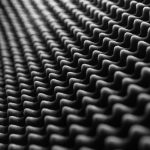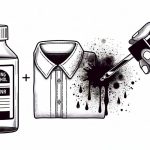I’m sure a lot of us have wondered about this question and many more that follow. Can you eat fabric? Is it possible to ferment fabric for alcohol? How about peeling our clothes off and then eating them?
It might sound like goofy questions, but we actually need to know these answers, or else we could end up looking like a monkey. Here, I’ll tell you all about this crazy topic from top to bottom.
Table of Contents
Can You Eat Fabric?
The quick answer is no, you cannot eat fabric. While some animals can digest certain types of fabric, humans lack the ability to do so. Even if you were to ferment fabric for alcohol or try eating clothes, your body would not be able to break down these materials and absorb their nutrients.
This is because our digestive system is designed specifically for breaking down food that we eat – and while clothing is made from plant-based or synthetic fibers, these materials are not meant to be eaten by people (or any other animal).
So What Are The Risks Of Eating Fabric?
While it’s technically possible to choke on a piece of cloth or get an infection from eating contaminated clothing, the risks are relatively low. More often than not, people who eat fabric do so because they’re suffering from a mental illness called pica.
Pica is an eating disorder that compels someone to consume non-food items, and it can be incredibly dangerous if the person eats something that’s poisonous or harmful (like lead paint chips). So while eating small amounts of fabric probably won’t kill you, it’s still not a good idea – especially if you don’t know what the material is made out of.
This matters because our digestive system is not designed to process materials like clothing fibers. Eating clothes could potentially cause choking or infection, and people with mental illnesses such as pica are especially at risk.
Is Fabric Digestible?
Textiles are not able to be broken down and passed through the digestive system like a stick. They also do not have the same nutritional value as food items such as meat, fish, or eggs.
That said, there are many ways that fabrics can be digested. The most common way is through bacterial digestion; this is the process where bacteria break down cellulose fibers into smaller molecules like glucose and then absorb them into their cells. This is how clothing becomes worn out over time.
The second way is through chemical digestion; this is when chemicals break down fibers by chemically reacting with them in a controlled environment like inside an industrial washing machine or dryer or in a specialized textile treatment plant.
Finally, there are some fabrics that are made from materials that can be digested by your body’s enzymes — namely cellulose and starch — but these are only found in natural fibers like cotton, linen, and leather.”
Is Eating Fabric Bad for You?
One could ingest fabric, depending on the material it is made of. Mostly such things would just pass through your gut and exit your body in feces. Anything you can’t digest will do this—fiber among other materials —but there are some things you can’t digest that are very bad for you.
If you eat something that cannot be broken down by our bodies and is too large to pass through the gut, it can become lodged in your esophagus or the intestine.
If you’re concerned about the safety of the fabric, check out the manufacturer’s website for more information about where its materials come from and what they contain.
Why Are People Eating Fabric?
People are eating fabric? Well, that’s not good.
Pica is a compulsive eating disorder in which people eat non-food items. It’s often seen in children and pregnant women, but it can affect anyone at any age. The most common causes of pica are iron-deficiency anemia and malnutrition, followed by pregnancy.
There are three types of pica: geophagy, pagophagy, and amylophagy.
Geophagy refers to the consumption of soil or clay by someone who believes it will cure or prevent illness. Pagophagy involves the eating of ice or other frozen foods.
Amylophagy refers to the consumption of starch products like laundry starch or cornstarch as a substitute for food.
If you’re worried about yourself or someone else with pica, talk to your doctor about treatment options today!
What Kinds of Fabrics Can Humans Eat?
Fabrics made from natural fibers like cotton, linen, and leather are generally easier to digest than synthetic fabrics like polyester. This is because natural fibers are composed mainly of cellulose and starch, which humans can digest.
Synthetic fibers, on the other hand, are composed mainly of polymers, which are large molecules that can’t be broken down by the human body.
Do I Need to See a Doctor if I Accidentally Ate Fabric?
Yes, you should always see a doctor if you accidentally eat fabric.
Fabric isn’t toxic, so it’s unlikely that eating fabric will harm you. However, eating fabric can cause an obstruction in your digestive tract, which can be very dangerous.
Your doctor will be able to tell you whether you need treatment or not.
Are There Any Health Benefits to Eating Fabric?
No, there are no health benefits to eating fabric.
Eating fabric won’t make you healthier, and it won’t improve your digestion. In fact, eating fabric can cause an obstruction in your digestive tract, which can be very dangerous.
Can You Eat Your Clothes to Survive?
No, you can’t eat your clothes to survive.
If you’re worried about survival in a post-apocalyptic world, don’t worry too much about eating your clothes! The human body is designed to process food and fabric isn’t food. It’s not going to help keep you alive if the apocalypse comes tomorrow!
Conclusion
There are many dangerous things that people do to their bodies. They smoke, they eat junk food, and they take drugs. But can you eat fabric?
The quick answer is no, you cannot eat fabric. While some animals can digest certain types of fabric, humans lack the ability to do so. Even if you were to ferment fabric for alcohol or try eating clothes, your body would not be able to break down these materials and absorb their nutrients.
FAQ’s
Can You Eat Cotton?
It’s called the “cotton ball diet,” and some social media influencers have been sharing it as a way to lose weight. The diet consists of eating cotton balls to fill up your stomach so that you don’t feel hungry because there are literally zero calories in them
The cotton ball diet may seem harmless, but the balls can cause intestinal blockages that may lead to pain and potentially hospitalization.
Moreover, cotton balls have no nutritional value.
Is Eating Thread Okay?
While it may seem like a harmless thing to do, eating thread can cause intestinal blockages that may lead to pain and potentially hospitalization. Thread is made of cotton or other natural fibers, which are indigestible by humans. If you eat thread, it will not be broken down in your stomach or intestines and could get stuck there causing an obstruction.
Can I Eat My Shirt?
No, you cannot eat your shirt.
While it may seem like a harmless thing to do, eating your shirt can cause intestinal blockages that may lead to pain and potentially hospitalization. Shirt fabric is made of cotton or other natural fibers, which are indigestible by humans. If you eat your shirt, it will not be broken down in your stomach or intestines and could get stuck there causing an obstruction.
- Where to Buy Fabric in China: Top Sources and Markets - June 20, 2025
- The Most Highly Prized Fabric in Ancient China - June 20, 2025
- What Type of Fabric Is Chino? Understanding Chino Material - June 20, 2025





